We were lucky enough to have my parents come and visit us in Vietnam for two weeks. Read this post for information about the first week in Northern Vietnam.
Hue (Days 9-11)
We got back into Hanoi at 5:30am and took a cab to the airport for our flight to Hue (said way). By early afternoon we had landed in Hue where it was pouring rain. We checked into our hotel and promised to meet up for dinner.
Unfortunately, I woke up from my afternoon nap with a fever. So my time in Hue was spent admiring the ceiling and four walls of our hotel room. Thankfully no one else caught what I did, and their trip continued. Ben will take it from here.
We arrived in Hue under significant cloud cover and with one of our party (Sarah) down for the count with an illness she just couldn’t shake. While this set up is any short-term traveller’s worst nightmare, the sights and people we came across in Hue made it one of our favorite stops of the trip.
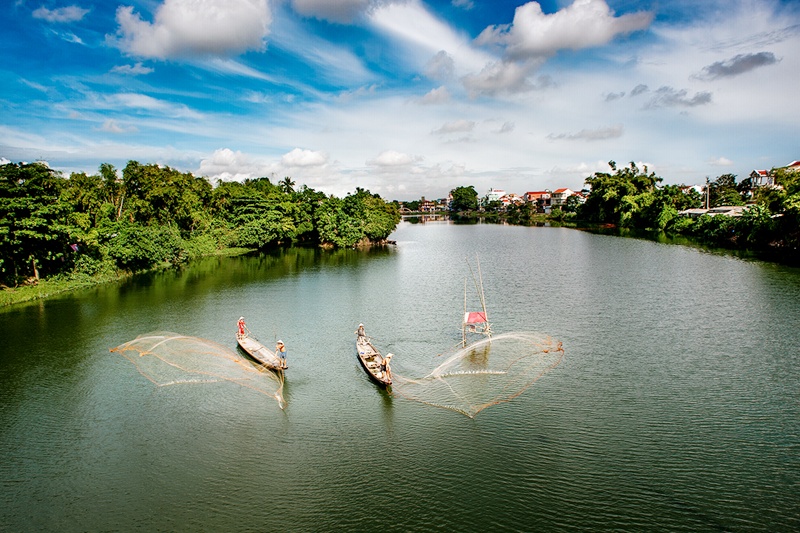
Hue’s Perfume River. Photo from Hue City Tour.
Sarah’s parents and I started out with an early breakfast in the hotel dining area anxiously listening to the rain outside shift from drizzling to raining to basically a waterfall. We had scheduled a walking tour for the morning but the weather was less than ideal. Yet we all agreed to brave the weather and set out from our hotel on the south bank walking towards the Perfume River.
We met our “Hue Free Walking Tour” guides at a small coffee shop and were given a final chance to back out. After agreeing it was impossible to get more waterlogged than we already were, we decided to press on and we sure are glad we did.
Our guides gave us a quick overview of Hue, the seat of the Nguyen Dynasty and the national capital from 1802-1945 and why it continues to be a cultural capital of sorts to this day, relative to its politically-minded sibling to the north or its business-focused sibling to the south.
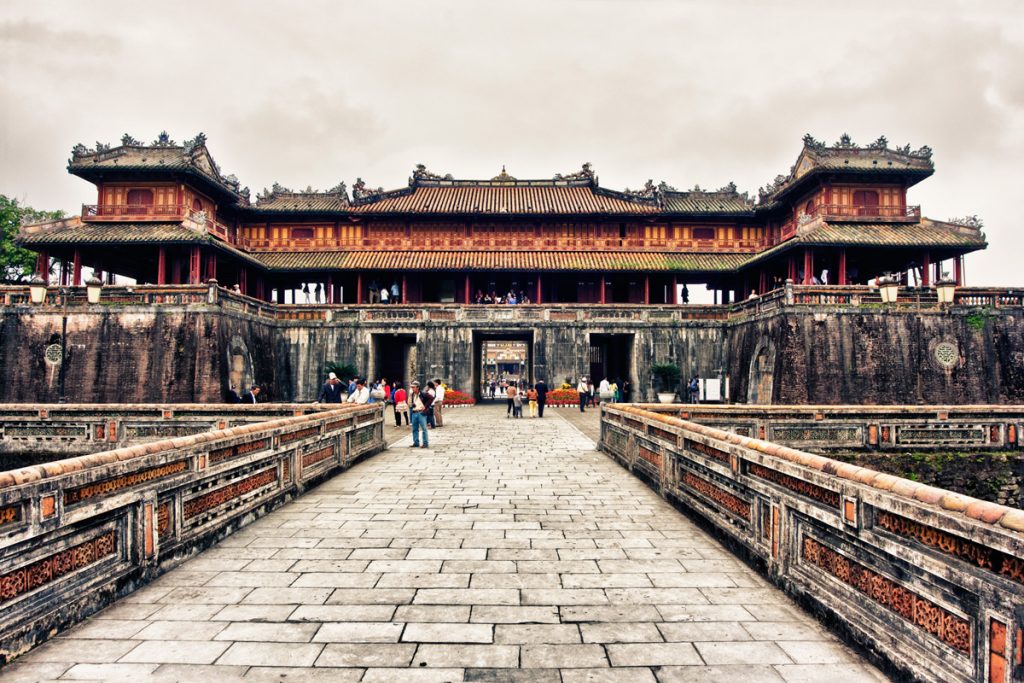
A view of the Citadel when it isn’t pouring. Photo by Vietnam Travel.
In addition, we touched on some very interesting legends regarding both the Perfume River and the significance of the placement of Hue’s citadel.
One legend told about how the river received its name states that many years ago an emperor was looking for a divine site from which to rule. While waiting for inspiration, he fell asleep and was told by a spirit to light a bunch of incense and float it down the river. The incense would stop burning at the ideal site. He followed the instructions when he awoke, lighting the incense and following it downstream where it stopped burning at the present-day site. Interestingly, the river is only called the Perfume River for foreigners – the Vietnamese name is Huong which, as it so happens, is the word for incense.
The placement of the citadel is seen as exceptionally special since it meets certain principles appreciated in geomancy (the art of placing or arranging buildings or other sites auspiciously). Most notably, the site of the citadel is placed on the river with islands found both to the left and the right (“dragon on the left, tiger on the right”) providing additional protection for the capital.
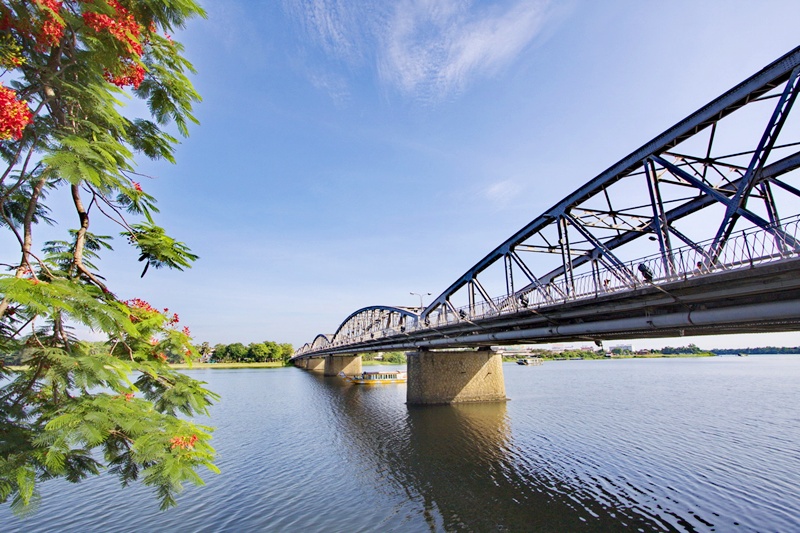
Truong Tien Bridge on a clear day. Photo from Hue City Tour.
We soon arrived at the Truong Tien bridge which, we were to learn, was actually designed by Gustave Eiffel a mere decade after his eponymous work in Paris. The French influence on this corner remained significant even to this day with the famed Morin Hotel still open and operating. While today you’re more likely to see families leaving the lobby, in its glory days it hosted notable dignitaries and stars – including Charlie Chaplin who may or may not stayed here with multiple wives for his honeymoon(s).
A stroll across the bridge to the north bank brought us to a large tree shading a large, round, concrete structure built right into the sidewalk. This was a bunker built by Americans during the Vietnam war to take advantage of the choke point created by the bridge. There was nothing marking it or signifying it in any way (it’s currently being used as a storage container) but its presence provided a poignant reminder of Hue’s place in history.
A turn to the right brought us to the Dong Ba market. Unlike most of the markets located near touristy spots across Vietnam, this one was very much still used by locals. Items ranged from incredibly fresh and colorful produce to fresh meats and cooked foods and all manner of textiles and trinkets.
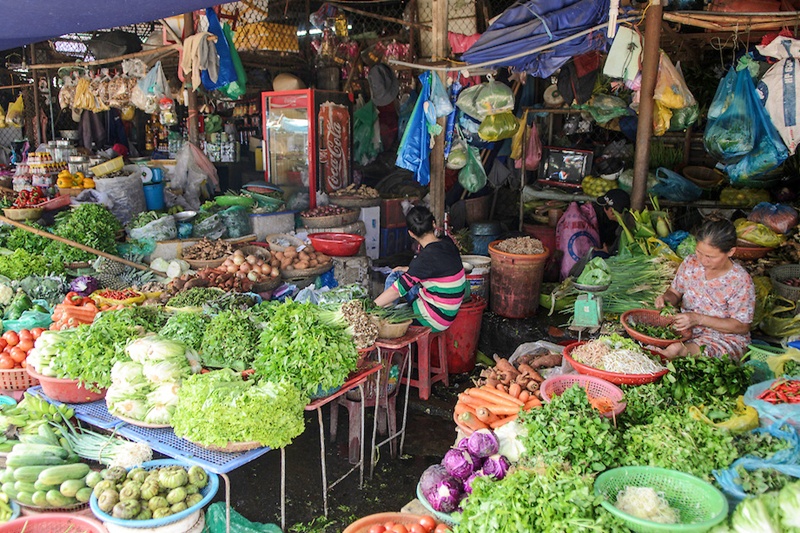
A photo of Dong Ba Market. Photo from Hue City Tour.
We continued our journey through back streets towards the citadel, finally reaching a street that stood on the other side of the moat. On first view, the scene is impressive to say the least. A waterway approximately 30 feet wide creates separation between the outside world and the capital. In different times, this moat would be filled with sharpened spikes. If that isn’t enough of a deterrent, the walls protecting the capital on the other side of the moat are 20-to-30 feet thick and 10-to-20 feet tall.
At first, this defense seems like overkill. However, upon further reflection, I realized this was a bare minimum level of safety. You see, the emperors are thought to have had as many as 500 wives… meaning nearly 1,000 in-laws. After spending two weeks with the two that I’ve got, the moat and walls made more and more sense to me.
But I digress. We passed through one of the gates running over the moat and through the wall. It hasn’t been updated or modernized in its design but now allows motorbike and car traffic in addition to pedestrians, creating an up close comparison of “old versus new.”
The roads lead to the front gates of the citadel which has further protective measures, mainly in the form of another massive wall, along with a huge courtyard where cannons and the second largest flag in Vietnam are on display.
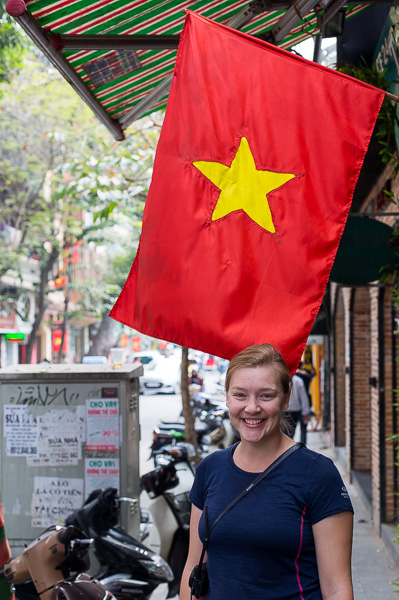
Sarah modeling with the Vietnamese flag.
While the tour itself was informational and entertaining, the main attraction for all of us was the cultural exchange taking place as our guides shifted to being our friends. We learned how they viewed their country and how they see their future developing. What traditions they found important wanted to carry forward and areas where they were clashing with the past and what was expected of them.
Once the tour had ended, we dragged our sopping wet selves back to the hotel just in time for our next activity of the day, a food tour.
Our food tour started promptly at 2:00pm, giving us just enough time to go from dripping wet to simply soaked following our walking tour in the morning. We were greeted by the tour guide and a fleet of cyclos, standing at attention and waiting to whisk us off on our food odyssey.
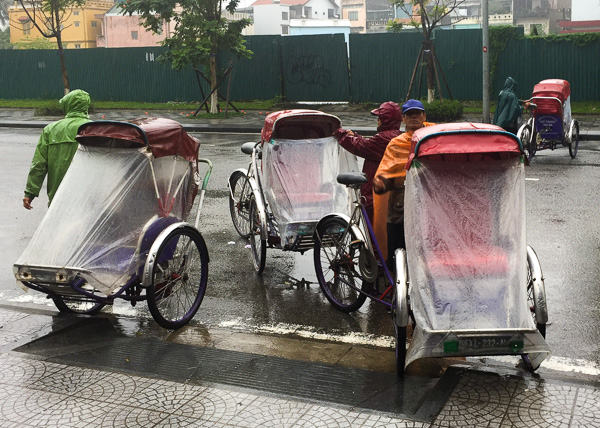
Cyclos in the rain, and one of the only photos we got on this wet day.
The food in Hue isn’t just good… it’s great. Due to Hue serving as the seat of power, its tight connection to leaders within the Buddhist faith, and its geographical presence in the center of the country, three distinctive and delicious segments of cuisine were formed. This includes the “humble” food of every day people, exceptionally flavorful vegetarian dishes, and elegant royal delicacies for more special occasions.
Our first stop started strong with the city’s most iconic and well known dish, bun bo hue. This fiery lemongrass and beef-broth soup is a major step-up from pho, packing much more flavor into the same bowl. It comes with thicker, round noodles that retain their texture in addition to an assortment of meats (typically beef, maybe some pork or sausage), veggies (onion, banana blossom, etc.), and typical condiments (lime wedges, herbs, bean sprouts, etc.). We also dug into some cha or meat pie which is minced meat steamed in a banana leaf.
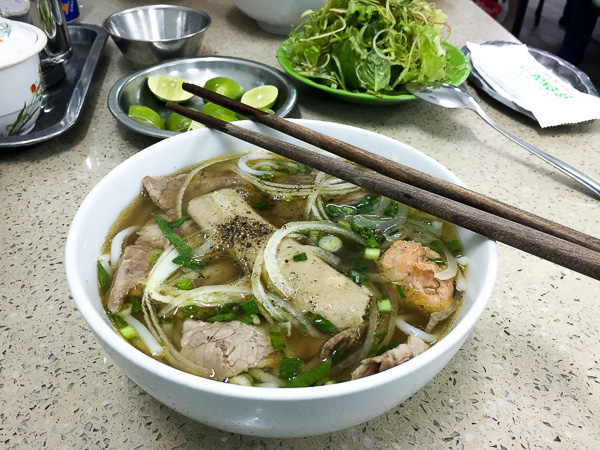
Bun Bo Hue, aka Sarah’s favorite Vietnamese food.
For those in the Minneapolis area, Lotus serves up a reasonably good bun bo hue. Feel free to take it to go and settle in at my parents’ condo close by! Parking $5.
We then rolled onward to a nearby bahn bao stand. These are dumplings almost the size of a softball stuffed with meat, a quail egg, and some great sauce before being steamed to a warm temperature. I was secretly happy Sarah wasn’t along for this part of the tour because I got one all to myself while everybody else had to share!
The cyclos retraced their route back towards our hotel before turning onto the main drag, crossing the Truong Tien bridge, and returning to one of our stops on the walking tour; the Dong Ba market. Our visit was more food-focused this time around and we tried bahn la gai or thorny leaf cake. It’s made of sweetened sticky rice flour wrapped around a mung bean and wrapped in a banana leaf before being steamed.
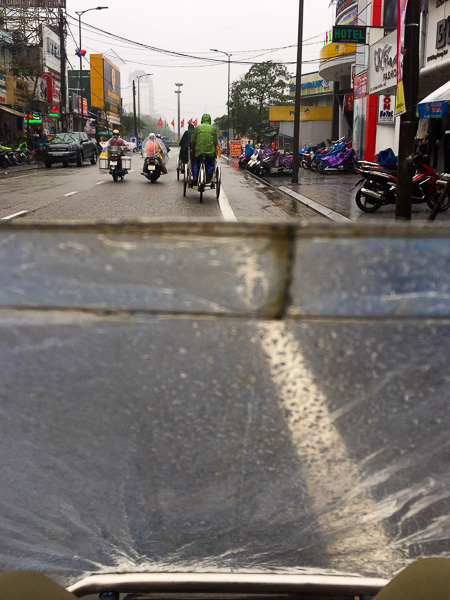
View from the cyclo on the food tour.
Our guide led us out of the market and to the northeast of the citadel to try banh chung which is a traditional Vietnamese rice cake served primarily during holidays. Its made from glutinous rice, mung beans, and pork, stuffed into a square-shaped banana leaf, and steamed.
Nearby, we stopped at a restaurant that only serves two dishes and learned that this makes ordering a breeze, even for non-native speakers! The first is a Hue pancake called bahn khoai. It’s made from mixing grated cassava, sugar, coconut milks, and salt before being fried and stuffed with bean sprouts and shrimp. You then take the pancake, top it with some herbs, wrap it up in either rice paper or lettuce leaves, and dunk it in the delicious dipping sauce it comes with. The other dish served nem lui or ground meat grilled on lemongrass skewers. These are also eaten by topping with some fresh herbs, rolling, and dunking.
Everybody was starting to get pretty full at this point so we fortunately took a little bit longer of a ride to our next stop. The restaurant was, again, pretty plain looking but with amazing charred meat smells emanating from the kitchen. The main item here was bun thit nuong or rice noodles with grilled meat. It’s served with cold rice noodles and warm grilled pork. Simply top with your desired herbs and sweetened fish sauce and you’re in for a treat. The second dish was banh uot or wet rice paper spring rolls, topped with fried shallots and eaten with nuoc cham (dipping sauce).
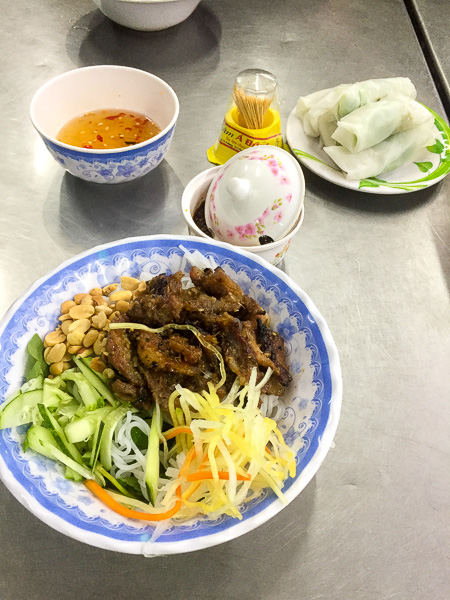
Bun Thit Nuong.
Our final “main” food stop was probably the most interesting and challenging for everybody on the tour. Here we had many dishes that would have traditionally been eaten by royalty. They were small, well designed, and packed with strong flavors and unique textures (which some appreciated and some didn’t) and included banh loc or filtered tapioca dumplings, banh beo or steamed rice disks topped with shrimp, banh nam or steamed flat rice dumplings, and ram it or sticky rice dumplings on a fried dumpling.
Now, it was time for dessert. Most of the time this consists of fresh fruits but on this tour, we started with che which means “sweet soup” and is really just a catch-all for a number of different sweetened flavorings in a gelatinous liquid. These included corn, beans, lotus seeds, and sweet potato, amongst others. We also tried me xung or a packaged sesame candy that is incredibly chewy.
The tour commenced at a well-known coffee stop where were slowly sipped on the addictive ca phe sua or Vietnamese coffee with condensed milk and munched on a final treat, green mango dipped in chili salt.
It was a great experience that we all enjoyed, so much in fact that we revisited a number of the same locations the next day!
Hoi An (Days 12-14)
When it was time to leave Hue for Hoi An, I was feeling good enough to travel, but definitely not 100%. Thankfully we just had a short and scenic train ride from Hue to Danang along the Hai Van Pass, and then a 45 minute cab ride from Danang to Hoi An.
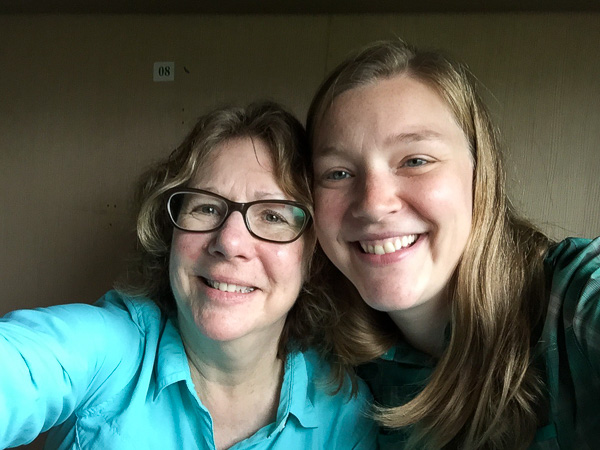
A train selfie on the Hải Vân Pass.
We had “splurged”(which means we spent more than $20/night) on a hotel in Hoi An that was overlooking the river in Hoi An. Yet, when we tried to check in, we were told that construction next door would make our stay quite noisy. So they moved us to a sister hotel that had just opened three months prior. The hotel was beautiful and just a 10 minute walk into the Ancient Town of Hoi An.
We headed right into Hoi An to grab some food, but our lunch was delayed by my mom stopping to check out every shop we passed. Hoi An Ancient Town is a Unesco World Heritage site that is comprised of well-preserved architecture from the 15th-19th centuries. While the early influences were Chinese and Japanese, European architecture is also very present in this cute former trading port. Now, a majority of the store fronts are filled with handicrafts, and my mom was in heaven checking out all of the textiles shops and art galleries that we passed. When we finally arrived at our lunch destination, we had fun introducing my parents to two dishes only found in Hoi An; white rose dumplings and cao lau.
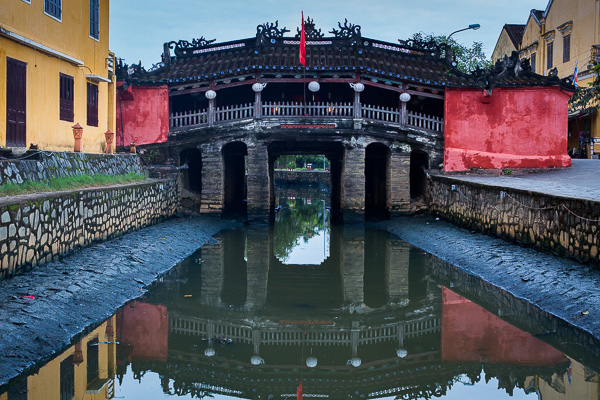
The Japanese Bridge in Ancient Town.
On our final day together we spent the day wandering around the Ancient Town, eating delicious food, and enjoying each other’s company. We spent the afternoon at the beach and enjoyed some massages at our hotel’s spa before heading out for our final dinner together.
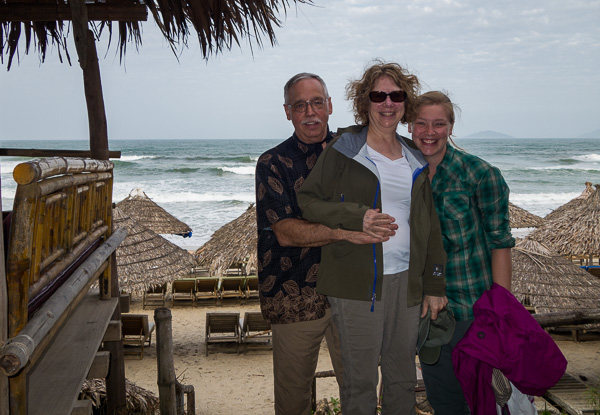
The only time my mom has ever been taller than my dad and I. Thank goodness we documented it for her.
Now that they have landed safely back in Minnesota, I think we can say it was a successful trip. We had so much fun sharing not only our favorite place with them, but also sharing our new lifestyle with people who are so important to us. For us travel is more than just taking a trip to a new place, and it was fun to try and demonstrate that to them firsthand. We were thrilled that they were willing and able to come and visit us a world away. That they tried so many new things, and that even when they were outside their comfort zone, which was essentially 24/7, they did their best to roll with it.
Since jet lag is a challenging foe it might be too soon to think about, but we look forward to hosting them again, if they are up for it.
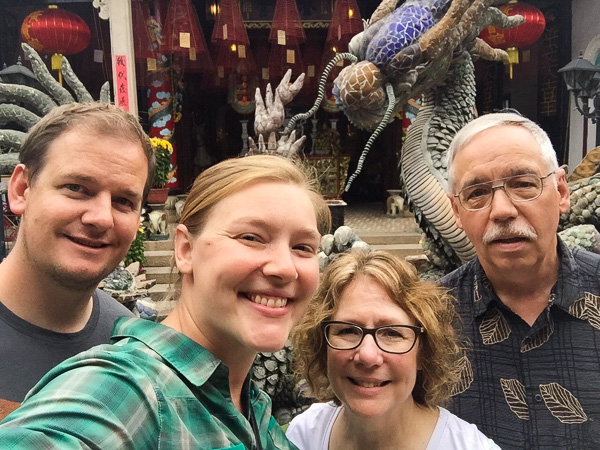
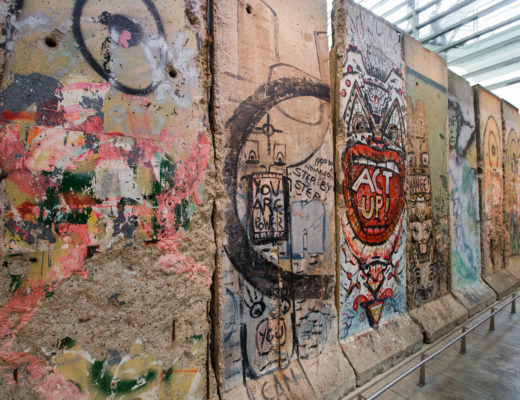
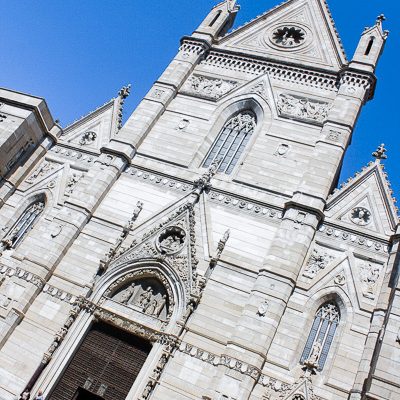
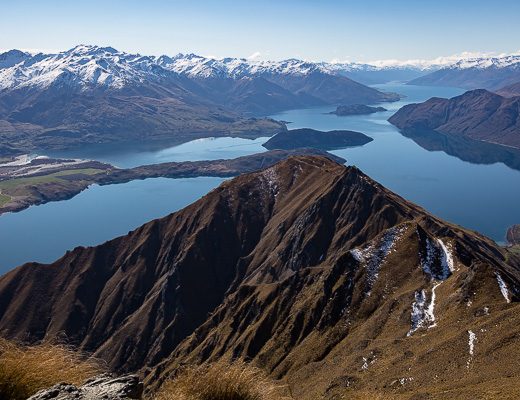
Goose
March 27, 2017 at 9:54 pmSo thrilled for the four of you to have spent this time together. I hope the stars align and we can join you for an upcoming adventure!
And… I must add, for Aunt Jan’s sake, that she will appreciate that you informed people of the parking rates at the Hyatt by our condo. 😊